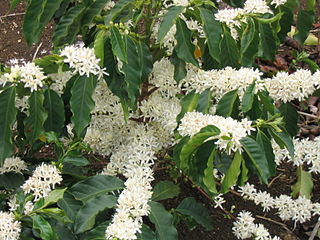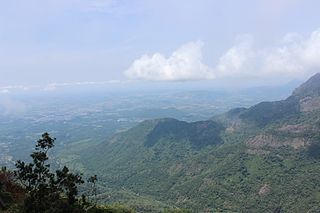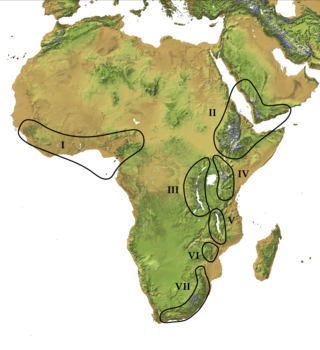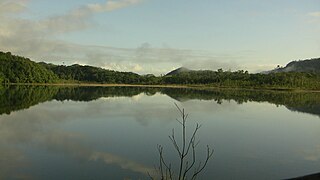
Coffea arabica, also known as the Arabica coffee, is a species of flowering plant in the coffee and madder family Rubiaceae. It is believed to be the first species of coffee to have been cultivated and is the dominant cultivar, representing about 60% of global production. Coffee produced from the less acidic, more bitter, and more highly caffeinated robusta bean makes up most of the remaining coffee production. The natural populations of Coffea arabica are restricted to the forests of South Ethiopia and Yemen.

The Río Plátano Biosphere Reserve is a protected area in the La Mosquitia region on the Caribbean coast of Honduras. With a total area of 5,250 square kilometers (2,030 sq mi), most of the reserve runs along the Río Plátano. The reserve has a number of endangered species and some of the largest remnants of tropical forest in Central America. It has been a World Heritage Site and biosphere reserve since 1982. In 2011, UNESCO placed the reserve on the List of World Heritage in Danger.

The Nilgiri Biosphere Reserve is a biosphere reserve in the Nilgiri Mountains of the Western Ghats in South India. It is the largest protected forest area in India, spreading across Tamil Nadu, Karnataka and Kerala. It includes the protected areas Mudumalai National Park, Mukurthi National Park, Sathyamangalam Wildlife Sanctuary in Tamil Nadu; Nagarhole National Park, Bandipur National Park, both in Karnataka; Silent Valley National Park, Aralam Wildlife Sanctuary, Wayanad Wildlife Sanctuary, and Karimpuzha Wildlife Sanctuary in Kerala.

The Golden Gate Biosphere Network is a voluntary coalition of federal, state and local government agencies, nonprofit organizations, universities, and private partners within the Golden Gate Biosphere region. The Network aims to protect the region's biodiversity and conserve its natural resources. The Network has been part of the UNESCO Man and Biosphere Programme since 1988 and is part of the US Biosphere Network as well as EuroMAB. It is recognized by UNESCO for its "significance for biological diversity conversation" and organizational efforts involving municipal authorities and private interests.

The Afromontane regions are subregions of the Afrotropical realm, one of the Earth's eight biogeographic realms, covering the plant and animal species found in the mountains of Africa and the southern Arabian Peninsula. The Afromontane regions of Africa are discontinuous, separated from each other by lower-lying areas, and are sometimes referred to as the Afromontane archipelago, as their distribution is analogous to a series of sky islands.
Yayo is one of the districts in the Oromia Region of Ethiopia. Part of the Illubabor Zone, Yayo is bordered on the south by the Southern Nations, Nationalities and Peoples Region, on the west by Matu, on the north by Supena Sodo, on the east by Chora, and on the southeast by the Jimma Zone. Towns in Yayo include Elemo and Yayo. Doreni and Hurumu districts were part of Yayo district.
COCE is the name of a research project and stands for "Conservation and Use of Wild Populations of Coffea arabica in the Montane Rainforests of Ethiopia".

The main causes of deforestation in Ethiopia are shifting agriculture, livestock production and fuel in drier areas.

Deforestation is one of the most serious environmental issues in Sri Lanka. Sri Lanka's current forest cover as of 2017 was 29.7%. In the 1920s, the island had a 49 percent forest cover but by 2005 this had fallen by approximately 26 percent. Between 1990 and 2000, Sri Lanka lost an average of 26,800 ha of forests per year. This amounts to an average annual deforestation rate of 1.14%. Between 2000 and 2005 the rate accelerated to 1.43% per annum. However, with a long history of policy and laws towards environmental protection, deforestation rates of primary cover have decreased 35% since the end of the 1990s thanks to a strong history of conservation measures. The problem of deforestation in Sri Lanka is not as significant in the southern mountainous regions as it is in northern and lowland southern Sri Lanka, largely due to the nature of environmental protection.
The Kruger to Canyons Biosphere Region is a biosphere reserve situated in the north eastern region of South Africa, straddling Limpopo and Mpumalanga Provinces. In 2001, under the supervision of the then Department of Environmental Affairs (DEA), the Kruger to Canyons Biosphere Region was officially ratified by UNESCO as part of the Man and the Biosphere (MaB) Programme. UNESCO's Man and the Biosphere Programme provides a framework for exploring local solutions to challenges by mainstreaming biodiversity conservation and sustainable development, integrating economic, social and environmental aspects and recognising their vital linkages within specific learning landscapes adjacent to Protected Areas.
Keffa or Kaffa, is a zone in the South West Region of Ethiopia. The administrative center is Bonga.

Kogelberg Nature Reserve is a nature reserve of 3,000 ha comprising the Kogelberg Mountain Range, to the east of Cape Town, South Africa.
Biosphere reserves are established according to the UNESCO's Man and the Biosphere Programme (MAB) to promote sustainable development for conservation of biological and cultural diversity. As of 2016, the Lal Suhanra Biosphere Reserve and Ziarat Juniper Forest are the only two biosphere reserve in Pakistan, which were approved by UNESCO in 1977 and 2013 respectively. A number of initiatives and projects have been undertaken to promote and develop other biosphere reserves in Pakistan but due to weak implementation this has not yet been materialized. In July 2012, Pakistan Museum of Natural History and Beijing Museum of Natural History signed a MoU to work on trans-boundary biodiversity and to improve MAB related activities in the Karakoram, Himalaya, and Hindukush regions.

The Ethiopian montane forests is a tropical moist broadleaf forest ecoregion in Ethiopia. It covers the southwestern and southeastern portions of the Ethiopian Highlands. The ecoregion includes distinctive Afromontane evergreen forests. The ecoregion's biodiversity is threatened by deforestation, conversion to agriculture, and overgrazing.
The Sheka Forest is a UNESCO designated Biosphere Reserve in south western Ethiopia. The area includes forest, bamboo thickets, wetlands, agricultural land, rural settlements and towns. It covers a unique biogeographic unit extending from cold and very wet highlands to hot lowland areas. The diverse resident human population is committed to sustainable use of the forests through both the production of wooden items and non-timber forest products. It was declared in 2012 and is administered by SNNP Region Bureau of Agriculture, Sheka Zone Administration, Sheka Zone Department of Agriculture, Masha Woreda Office of Agriculture, Anderacha Woreda Office of Agriculture, Yeski Woreda Office of Agriculture. The reserve covers a core area of 238,750 hectares, with a buffer zone 76,395 hectares and transition areas of 107,100 hectares.
The Kafa Biosphere Reserve is located in the Kafa Zone of Ethiopia approximately 460 km southwest of Addis Ababa. The Bonga National Forest Priority Area partly forms the southern boundary of the Biosphere Reserve, whilst the eastern boundary follows the Adiyo Woreda with the Gojeb River and Gewata-Yeba (Boginda) National Forest Priority Area forming the northern boundary.
The Lake Tana Biosphere Reserve is a protected area located in the Amhara National Regional State approximately 563 km northwest of Addis Ababa in the north-western part of Ethiopia. The biosphere reserve comprises Lake Tana, the largest lake in Ethiopia, the main source of the Blue Nile, which provides important ecosystem services. The area is a hotspot of biodiversity, internationally known as an Important Bird Area and is of global importance for agricultural genetic diversity. The area is characterized by an enormous heterogeneity of land uses and natural ecosystems.

The Magaliesberg Biosphere Reserve is located in South Africa between the cities of Pretoria and Johannesburg to the east and Rustenburg to the west. The reserve lies at the interface of two great African biomes — the Central Grassland Plateaux and the sub-Saharan savannah — and the remnants of a third biome, the Afro‐montane forest. The rich biodiversity includes floral species such as Aloe peglerae and Frithia pulchra, and faunal species such as the forest shrew, sable antelope and 443 bird species representing 46.6% of total bird species in the southern African sub-region.

The Island of Príncipe Biosphere Reserve is a UNESCO Biosphere Reserve in São Tomé and Príncipe. It encompasses the entire emerged area of the island of Príncipe, its islets Bom Bom, Boné do Jóquei, Mosteiros, and Pedra da Galé, and the Tinhosas islands as well as surrounding marine habitats. The reserve is located in the Gulf of Guinea off the west coast of Africa, and is managed by the regional government of Príncipe.

Nahá–Metzabok Biosphere Reserve is a biosphere reserve in southeastern Mexico. It is located in the state of Chiapas, on the northeastern flank of the Chiapas Highlands. The reserve protects montane rain forests, pine and oak forests, and natural lakes.












